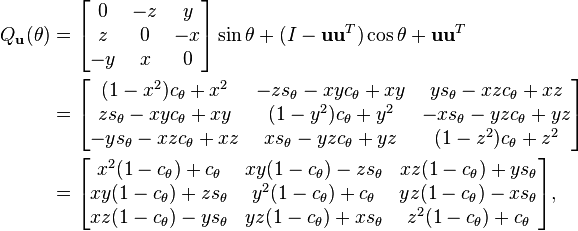Nested Dimensions
A 3×3 rotation matrix like
suggests a 2×2 rotation matrix,
is embedded in the upper left corner:
This is no illusion; not just one, but many, copies of n-dimensional rotations are found within (n+1)-dimensional rotations, as subgroups. Each embedding leaves one direction fixed, which in the case of 3×3 matrices is the rotation axis. For example, we have
fixing the x axis, the y axis, and the z axis, respectively. The rotation axis need not be a coordinate axis; if u = (x,y,z) is a unit vector in the desired direction, then
where cθ = cos θ, sθ = sin θ, is a rotation by angle θ leaving axis u fixed.
A direction in (n+1)-dimensional space will be a unit magnitude vector, which we may consider a point on a generalized sphere, Sn. Thus it is natural to describe the rotation group SO(n+1) as combining SO(n) and Sn. A suitable formalism is the fiber bundle,
where for every direction in the "base space", Sn, the "fiber" over it in the "total space", SO(n+1), is a copy of the "fiber space", SO(n), namely the rotations that keep that direction fixed.
Thus we can build an n×n rotation matrix by starting with a 2×2 matrix, aiming its fixed axis on S2 (the ordinary sphere in three-dimensional space), aiming the resulting rotation on S3, and so on up through Sn−1. A point on Sn can be selected using n numbers, so we again have n(n−1)/2 numbers to describe any n×n rotation matrix.
In fact, we can view the sequential angle decomposition, discussed previously, as reversing this process. The composition of n−1 Givens rotations brings the first column (and row) to (1,0,…,0), so that the remainder of the matrix is a rotation matrix of dimension one less, embedded so as to leave (1,0,…,0) fixed.
Read more about this topic: Rotation Matrix, Decompositions
Famous quotes containing the words nested and/or dimensions:
“I was asking for something specific and perfect for my city,
Whereupon lo! upsprang the aboriginal name.
Now I see what there is in a name, a word, liquid, sane, unruly,
musical, self-sufficient,
I see that the word of my city is that word from of old,
Because I see that word nested in nests of water-bays, superb,
Rich, hemm’d thick all around with sailships and steamships, an
island sixteen miles long, solid-founded,”
—Walt Whitman (1819–1892)
“I was surprised by Joe’s asking me how far it was to the Moosehorn. He was pretty well acquainted with this stream, but he had noticed that I was curious about distances, and had several maps. He and Indians generally, with whom I have talked, are not able to describe dimensions or distances in our measures with any accuracy. He could tell, perhaps, at what time we should arrive, but not how far it was.”
—Henry David Thoreau (1817–1862)
